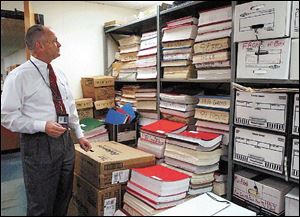
Bowling Green reassesses City Hall
1/6/2004
Mayor John Quinn surveys boxes and stacks of records in the copy machine room at Bowling Green City Hall. Documents for the personnel, finance, and mayor s offices are stored in the room.
BOWLING GREEN - Bowling Green s century-old City Hall can certainly be called a structure with character.
But that character is wearing thin on the 48 municipal employees who are jammed inside, sharing space with crates and boxes filled with records and documents.
Mayor John B. Quinn will address those concerns next week at his State of the City address when he announces a plan to form a committee to decide whether Bowling Green should renovate the two-story, red-brown brick building or start over.
Talk of change at City Hall is not new.
“Ten years ago there was a plan, when the question was asked, What could we do with this building? ” Mr. Quinn said yesterday.
At the time, the focus was on renovation. Two years ago, during a retreat for city administrators, the issue of the building s future again surfaced as a primary topic of discussion.
“Nothing happened with that plan,” he said.
Before 304 North Church St. became City Hall, the building served as an elementary school, then as the public library.
The city bought it in the mid-1970s and about 10 years later added an elevator. The interior was updated to include an atrium and reception desks on each floor. But a leaking roof and antiquated mechanical features demonstrate a need for bigger, modern features, the mayor said.
“It s very difficult to heat and cool a 100-year-old building,” Mr. Quinn said.
Signs of cramped quarters are evident to visitors in office areas, where overflowing closets are stuffed with boxes of records and file cabinets encroach on employee work space.
Mayor Quinn, who will formally present his plan Jan. 14, said word about the committee has generated interest among residents who have volunteered to serve.
The city s 2004 budget has set aside $750,000 for engineering studies and land acquisition, though a decision on whether to build on a new site or renovate will be up to the committee, he said.
Renovation would mean moving city government temporarily while the building is gutted, Mayor Quinn said. Construction would cost $7 million to $8 million, which is not much more than the cost to renovate and expand the facility. Mayor Quinn hopes to begin work in 2005.
The cost could be covered by issuing bonds, which would be repaid by city revenue, although he has not ruled out new taxes. Financing decisions would be up to the committee, which would include city officials as well as residents, he said.
Elaine Skoog, director of the Bowling Green Chamber of Commerce, said she was not aware of plans to replace city hall, but she expressed hope that the city would retain its downtown presence.
“The biggest thing is how they view their needs,” she said. “The building they re in now is pretty nice. But they ve probably outgrown their needs.”